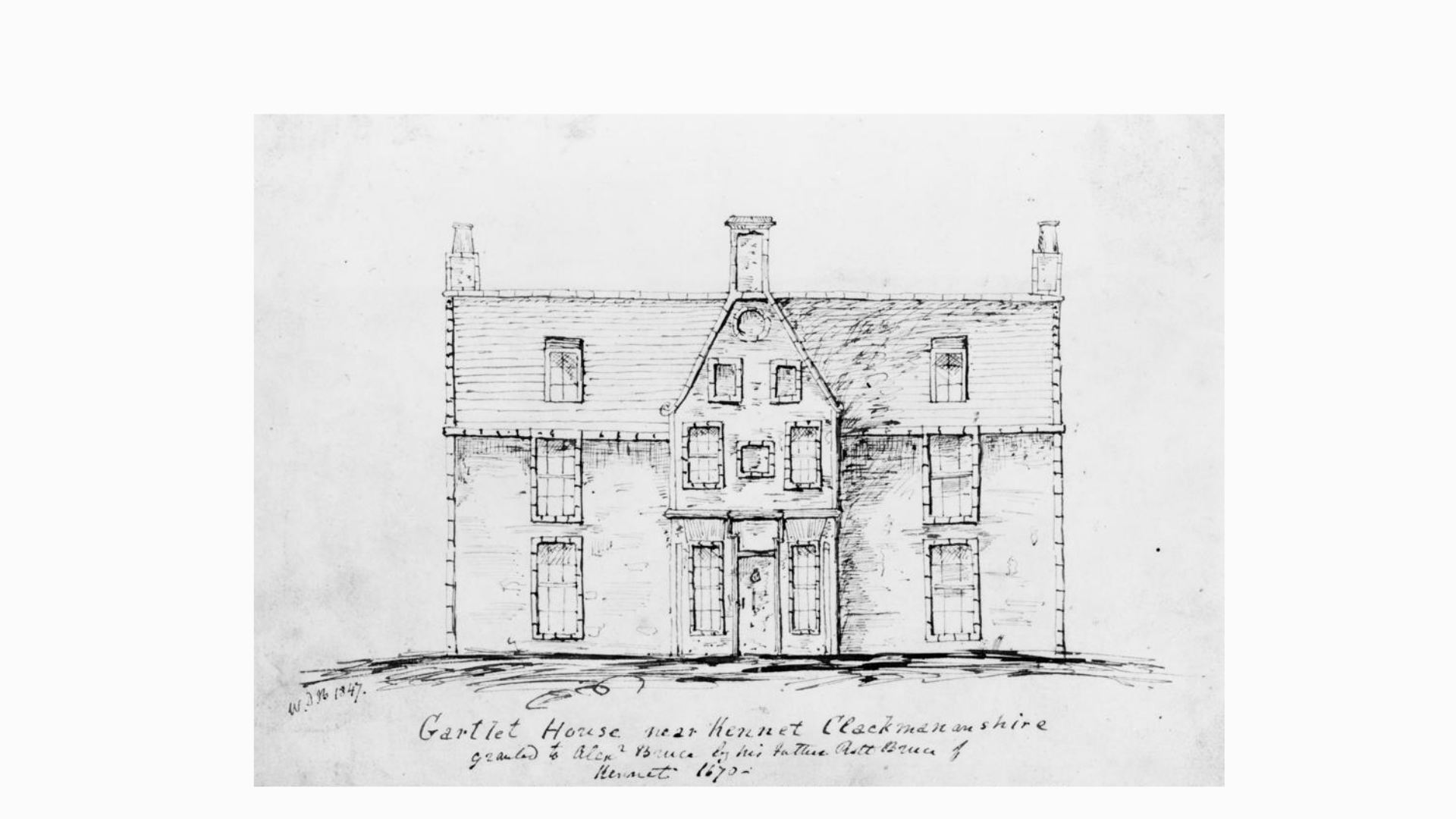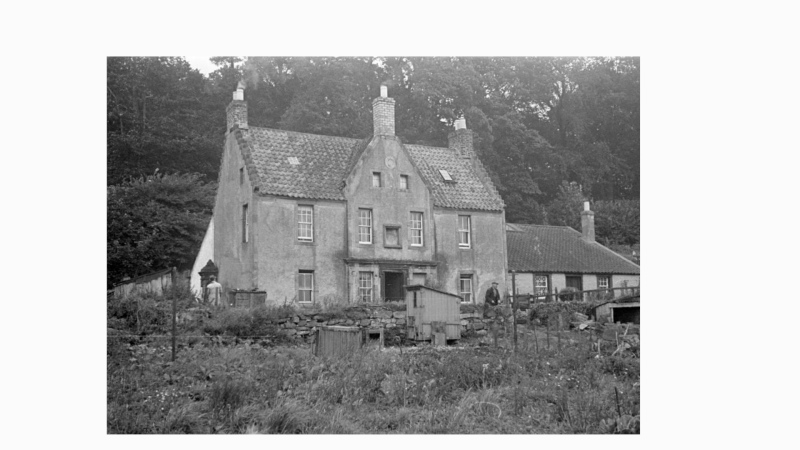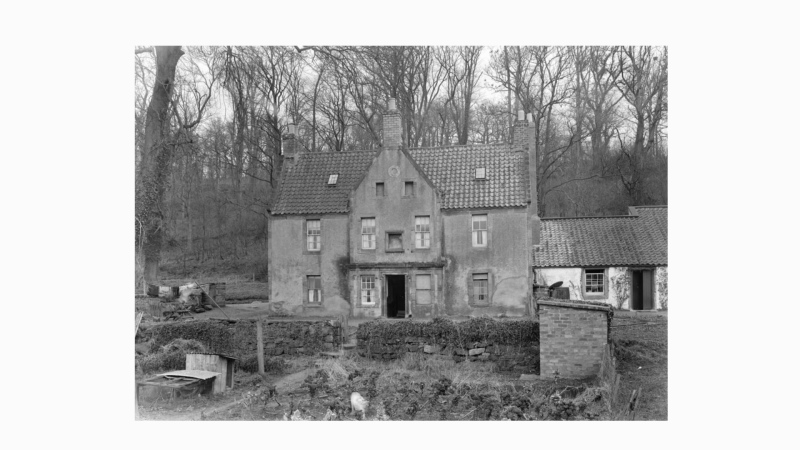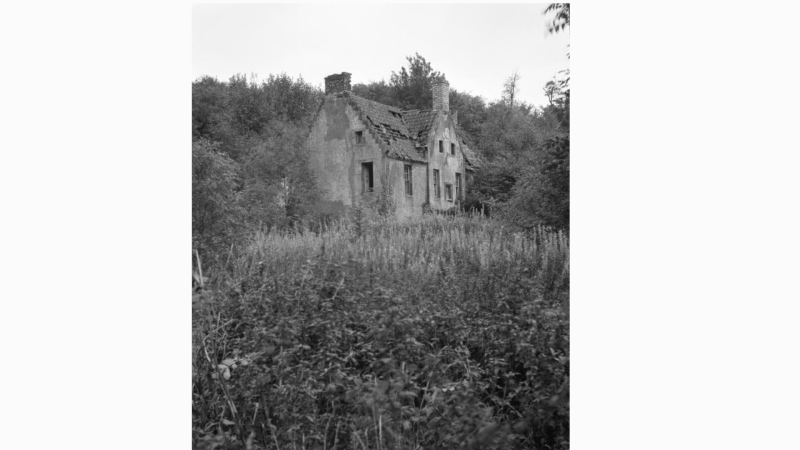Garlet House, and the collection of cottages adjoining, locally termed 'The Garlet', once stood in the Barony of Shanbody, almost immediately to the west of Kilbagie, Clackmannanshire.

Garlet House - Drawing by W. Downing Bruce 1847- Picture from Canmore.org.uk
The 'House' was built in the (possibly late) 17th century and was added to in several phases. Before the hamlet was demolished, it comprised of the house itself, an adjoining cottage, and a cottage row to the east, running north-south, comprising of possibly a further five cottages. This small hamlet, and it's neighbour, Kilbagie, were most likely instrumental in the demise of the tiny settlement of Shanbody which once stood close-by to the north of Kilbagie.
The house and nearby buildings sat at the foot of a wooded escarpment (a raised beach line), on the edge of enclosed arable farmland. The main house was cut into the lower slope of the escarpment and the soil removed therefrom used to build a terraced garden area. The house faced south-west overlooking the carse land.
The building changed hands several times over the years, a lot of these transactions are recorded by Kilbagie House resident W. Downing Bruce in his book "Collections towards a history of the County of Clackmannan".
The first recorded unit of land incorporating The Garlet is the barony of Shanbody, given to the Stewarts of Rosyth before 1363. The settlement of Shanbody itself is shown on a Victorian estate map as a ruined house north-east of Garlet House. Garlet as a named entity first appears in 1514, when it formed part of the terce, or marriage portion of Margaret Ogilvy, wife of Henry Stewart of Rosyth.
In 1629 Garlet was the birthplace of female education pioneer Mary Erskine, termed ‘Marie’ Erskine, eldest child of Robert Erskine and Beatrix Stupard ‘in Garlet.’ She was baptised in Clackmannan parish in May 1629. This indicates there was an earlier house on the site and it has been suggested that this earlier house was incorporated into the later 17th-century one, but no evidence was found for this in the archaeological excavation or building recording. Mary Erskine died in 1707 and left money for the Trades Incorporation to found what became Mary Erskine School, ‘one of the oldest girls’ schools in the world’.
The Bruces of Kennet bought Shanbody, including the lands of Garlet, from the Stewarts in 1647. Garlet was considered a secondary property to Kennet House and was granted to the second son, Alexander Bruce, in 1668. After his brother’s premature death in 1672–3, Alexander spent the next decade as the de facto manager of the family’s estates. Alexander cleared many debts during his nephew’s minority, while keeping his own land unencumbered. Comparable late 17th century rentals from neighbouring Kennet show that the rents were partly in kind (oats, meal, peas and bear), partly in money.
The precise date for the foundation of Garlet House is difficult to determine. The absence of a date stone has resulted in the reliance on documentary sources. Alexander Bruce is the only candidate for the builder of Garlet House and his marriage in 1677 would have given impetus to acquire a house. While his daughter Marion was born in Edinburgh in 1681, her sister was born in 1686 in Clackmannan parish, suggesting there was a house fit for occupation by the family. The house can be no more closely dated than the early-mid 1680s.
Alexander had kept Garlet separate from the financial disasters of Kennet, and when legal proceedings saw the Kennet tenants under oath in the 1690s, Garlet was absent. This suggests that he would have had sufficient resources at his disposal to build the imposing entrance front at Garlet House, albeit a ‘bonnet laird’s’ residence. Drummond suggests it was Kennet’s dower house, but it only seems to have assumed this function for Alexander’s widow after his death in 1704. Garlet passed to Alexander’s son, also Alexander, who practised as a doctor and apothecary in Edinburgh. In 1726 Garlet was sold to Dr Bruce’s sister, whose grandson John Jamieson compiled the pioneering Etymological Dictionary of the Scots Language (1808), and also kept notes on Garlet family history. Long periods of absentee ownership saw the house relatively unchanged, and it is little documented during the 18th century. However, the Bruces bought it back in 1766, although they do not seem to have lived in it themselves.
Kilbagie appears in the later 18th century, as a planted, or planned, settlement on land bought from the Kennet estate in 1776 by James Stein, a local farmer. He began distilling whisky on an industrial scale prior to 1771, utilising water from the Tulliallan estate that was used, variously, to drive three mills, three engines, and to supply the canal to nearby Kennetpans harbour.
Bruce of Kennet wished to improve the policies of his house in 1752, and petitioned to close the old customary right of way from Clackmannan to Kincardine, which ran through his garden. This originally ran along the old raised beach contour line from ‘the banks of Kilbagie and westwards by the north side of the lands of Garland (Garlet was known at times as Garland),’ to ‘Nether Green farm’. In 1762 under an act to enable enclosures it was rerouted northwards through Shanbody and Pilmuir (beside Clackmannan).
James Stein had been driven to bankruptcy in 1788 by punitive English excise duty of £3 (rising to £9) on a gallon of whisky. They owed £8,000, but as their annual tax contribution exceeded the entire land tax for Scotland, their closure was a short-sighted measure driven by English rivals. While it lasted it was said to have been the largest distillery in Europe, and ‘that dear Kilbaigie’ was mentioned by Burns, in his tract ‘The Jolly Beggars, ’in 1785.
Kilbagie Mill House, probably the original Kilbagie farmhouse, is comparable to Garlet in size and general appearance, although dated a century later. James Stein built the more modern Kilbagie House as a replacement and by 1793 Garlet, now known as Garland, was tenanted by his relative, Margaret Stein. The Garlet Bruces bought Kilbagie House in 1857 adding boundary walls and a dovecote, bearing the initials of William Downing Bruce.
In nearby Kincardine, a shipbuilding industry flourished during the later 18th and earlier 19th centuries, enjoying such natural advantages as 'a good roadstead and a hard gravel beach, on which vessels could be cleaned and repaired’ . John McLeay, one such shipowner, lived at Garlet/Garland until his death in 1820. He owned two thirds of the sloop ‘Garland of Kincardine,’ the remainder belonging to his sons-in-law, shipmasters in Kincardine.
Later occupants of Garlet were of lower social status, often working on Kennet estate. The Steins had let Kilbagie distillery to other whisky manufacturers by the 1840s, a chemical manure plant in 1866 and it had become a pulp and fibre mill by 1874. During the 1880s, the Bruce’s gamekeeper lived in one of the Garlet’s ancillary cottages; the mansion and Kilbagie House both being let to J A Weir of Forth paper mills. By the end of the century, the house had been divided into flats and seven families of paper mill workers and the Kennet coachman occupied the complex.

Garlet House - 1940's - Canmore
During the latter stages of World War II there was a fear that the house could be damaged by enemy activity, and so Garlet House was recorded by the Scottish National Buildings Record. The survey was carried out by an injured Polish architect, Stanislav Tyrowicz.

Garlet House - 1940's - Canmore
Isobel Drummond visited Garlet around the 1940s, when the only access to the first floor was by an external rear staircase, and observed that two upstairs rooms had been irregularly panelled. She suggested that the accompanying plaster frames ‘may have been painted with coloured designs, and one or more landscapes - similar [panelling is] at Pilmuir House - East Lothian,’ and is possibly early 18th century.
Maintenance of the buildings must have slumped dramatically between 1940 and 1955, since of the seven houses or cottages at Garlet, five were by then ‘uninhabitable,’ and one paper mill worker occupied another. By 1964, the whole area was unkempt and derelict.

Garlet House - 1964 - Canmore
Sadly the entire suite of buildings was demolished in October 1964. The land was left to return to nature. When Alexander Bruce’s descendants visited in 1968, the area was ‘all covered with brambles’. The site was visited again in 1973, by Ordinance Survey, who noted 'Only slight foundations remain'.
In the mid-2000's, with the building of the approach road for the Clackmannanshire Bridge, The remains of The Garlet were excavated for posterity, as they lay on the path of the new road to the north of the bridge. The findings from these excavations are recorded and presented in 'Garlet: Rediscovery of a laird's House in Clackmannanshire'. Reference materials are listed below.
The remains of 'The Garlet' (if any now exist) are now buried under the A876 approach road.
References:
Collections towards a history of the County of Clackmannan - W. Downing Bruce.
Canmore - www.canmore.org.uk
Atkinson, Jones, Cross and Mulcair, D, E, M, and J. (2009) "Garlet: rediscovery of a laird's house in Clackmannanshire"
